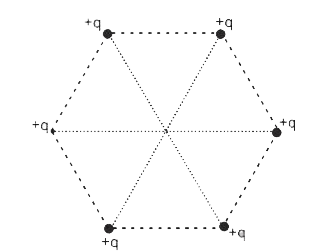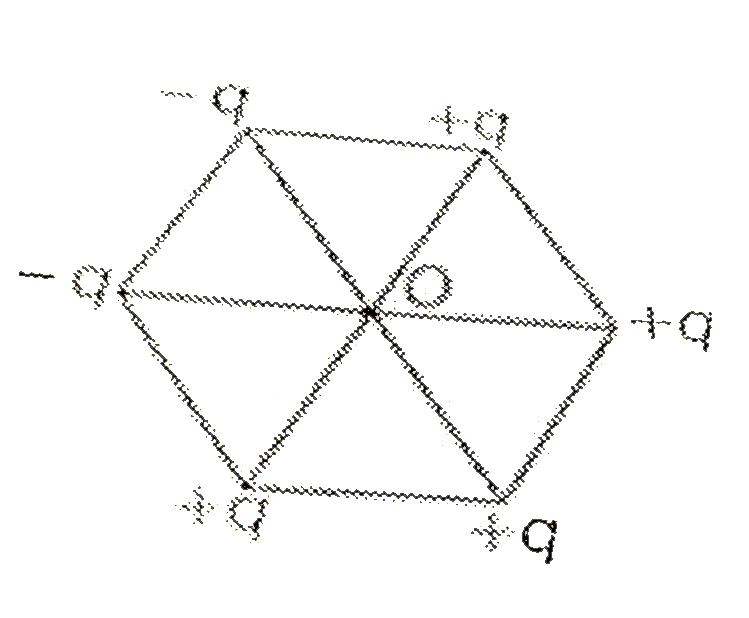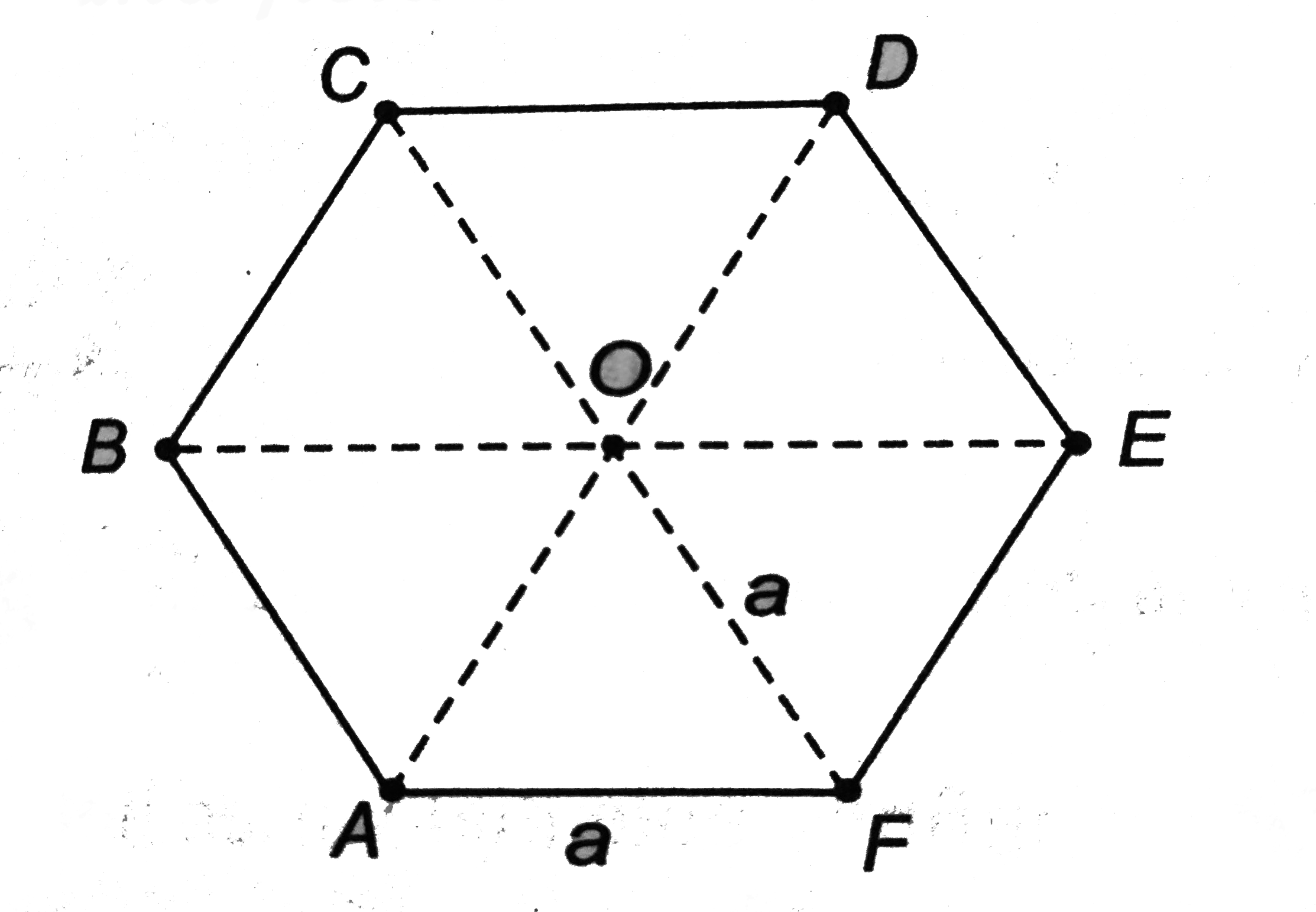Six point masses of mass m each are at the vertices of a regular hexagon of side l. Calculate the force on any of the masses.
To solve the problem of calculating the gravitational force on any of the masses located at the vertices of a regular hexagon, we can follow these steps:
Step 1: Understand the Configuration
We have six point masses, each of mass m, positioned at the vertices of a regular hexagon with side length l. We need to calculate the net gravitational force acting on one of these masses due to the other five masses.
Step 2: Calculate the Gravitational Force Between Two Masses
The gravitational force F between any two point masses m separated by a distance r is given by Newton's law of gravitation:
F=Gm2r2
For the masses at adjacent vertices of the hexagon, the distance r is equal to l. Therefore, the force between two adjacent masses is:
F=Gm2l2
Step 3: Identify the Forces Acting on a Selected Mass
Let’s consider one mass at a vertex of the hexagon. The other five masses exert gravitational forces on it. The forces exerted by the adjacent masses (two in total) are F and act along the sides of the hexagon. The forces exerted by the two opposite masses (which are directly across the hexagon) need to be calculated next.
Step 4: Calculate the Forces from Non-Adjacent Masses
The distance between the selected mass and the opposite mass (which is two sides away) is 2l. The gravitational force exerted by each of these two opposite masses is:
Fopposite=Gm2(2l)2=Gm24l2
Step 5: Resolve Forces into Components
Since the forces from the adjacent masses act at angles of 60∘ to each other, we can resolve these forces into their x and y components. The forces from the adjacent masses can be represented as:
- F1=Gm2l2 acting at 0∘
- F2=Gm2l2 acting at 120∘
The x and y components of these forces are:
- F1x=F
- F1y=0
- F2x=F⋅cos(120∘)=−F2
- F2y=F⋅sin(120∘)=F√32
Step 6: Calculate the Net Force from Adjacent Masses
The net x-component of the force from the two adjacent masses is:
Fnet,x=F+(−F2)=F2
The net y-component of the force from the two adjacent masses is:
Fnet,y=0+F√32=F√32
Step 7: Calculate the Forces from the Opposite Masses
The forces from the two opposite masses also need to be considered. Each of these forces acts directly downward (in the negative y-direction) and can be calculated as:
Fopposite,y=−Gm24l2
Step 8: Combine All Forces
The total y-component of the force acting on the mass is:
Ftotal,y=F√32−2⋅Gm24l2
The total x-component remains:
Ftotal,x=F2
Step 9: Calculate the Magnitude of the Net Force
The magnitude of the net force can be calculated using Pythagorean theorem:
Fnet=√F2total,x+F2total,y
Step 10: Substitute Values and Simplify
Substituting the values of F and simplifying will yield the final expression for the net gravitational force acting on any mass at the vertex of the hexagon.
Final Expression
The final expression for the net force acting on any mass at the vertex of the hexagon is:
Fnet=Gm2l2(34+1√3)
We have six point masses, each of mass m, positioned at the vertices of a regular hexagon with side length l. We need to calculate the net gravitational force acting on one of these masses due to the other five masses.
The gravitational force F between any two point masses m separated by a distance r is given by Newton's law of gravitation:
F=Gm2r2
For the masses at adjacent vertices of the hexagon, the distance r is equal to l. Therefore, the force between two adjacent masses is:
F=Gm2l2
Let’s consider one mass at a vertex of the hexagon. The other five masses exert gravitational forces on it. The forces exerted by the adjacent masses (two in total) are F and act along the sides of the hexagon. The forces exerted by the two opposite masses (which are directly across the hexagon) need to be calculated next.
The distance between the selected mass and the opposite mass (which is two sides away) is 2l. The gravitational force exerted by each of these two opposite masses is:
Fopposite=Gm2(2l)2=Gm24l2
Since the forces from the adjacent masses act at angles of 60∘ to each other, we can resolve these forces into their x and y components. The forces from the adjacent masses can be represented as:
- F1=Gm2l2 acting at 0∘
- F2=Gm2l2 acting at 120∘
- F1x=F
- F1y=0
- F2x=F⋅cos(120∘)=−F2
- F2y=F⋅sin(120∘)=F√32
The net x-component of the force from the two adjacent masses is:
Fnet,x=F+(−F2)=F2
The net y-component of the force from the two adjacent masses is:
Fnet,y=0+F√32=F√32
The forces from the two opposite masses also need to be considered. Each of these forces acts directly downward (in the negative y-direction) and can be calculated as:
Fopposite,y=−Gm24l2
The total y-component of the force acting on the mass is:
Ftotal,y=F√32−2⋅Gm24l2
The total x-component remains:
Ftotal,x=F2
The magnitude of the net force can be calculated using Pythagorean theorem:
Fnet=√F2total,x+F2total,y
Substituting the values of F and simplifying will yield the final expression for the net gravitational force acting on any mass at the vertex of the hexagon.
The final expression for the net force acting on any mass at the vertex of the hexagon is:
Fnet=Gm2l2(34+1√3)
Topper's Solved these Questions
- GRAVIATIONBOOK - PRADEEPCHAPTER - GRAVIATIONEXERCISE - ADVANCED PROBLEMS FOR COMPETITIONS
15 Videos
- GRAVIATIONBOOK - PRADEEPCHAPTER - GRAVIATIONEXERCISE - NCERT
21 Videos
- GRAVIATIONBOOK - PRADEEPCHAPTER - GRAVIATIONEXERCISE - SHORT ANSWER QUESTIONS V.
1 Videos
- BEHAVIOUR OF PERFECT GAS & KINETIC THEORYBOOK - PRADEEPCHAPTER - BEHAVIOUR OF PERFECT GAS & KINETIC THEORYEXERCISE - Assertion - Reason Type questions
14 Videos
- KINEMATICSBOOK - PRADEEPCHAPTER - KINEMATICSEXERCISE - 1 NCERT Comprehension
4 Videos
Similar Questions
Six equal point charges are placed at the corners of a regular hexagon of side 'a'. Calculate electric field intensity at the centre of hexagon ?

View SolutionThree masses of 1 kg each are kept at the vertices of an equilateral triangle of side 3 m. What is the force acting on a point mass of 5 kg placed at its centroid ?
View Solution
Knowledge Check
Six identical particles each of mass m are arranged at the corners of a regular hexagon of side length L. If the mass of one of the particle is doubled, the shift in the centre of mass is
ALB6L/7CL/7DL√3Six point charges are arrange at the vertices of a regular hexagon of side length a (shown in figure).

Find the magnitude of electric field at the centre of regular hexagon.Aq4πε0a2BzeroCq2πε0a2Dnone of theseFive point charge (+q each) are placed at the five vertices of a regular hexagon of side 2a.what is the magnitude of the net electric field at the centre of the hexazon?
A14πε0qa2Bq16πε0a2C√2q4πε0a2D5q16πε0a2
Five point masses m each are kept at five vertices of a regular pentagon. Distance of centre of pentagon from any one of the verticle is 'a'. Find gravitational potential and filed strength at centre.
View SolutionFive point charges each of charges +q are placed of five vertices of a regular hexagon of side 'l'. Find the magnitude of the resultant force on a charge -q placed at the centre of the hexagon.
(##U_LIK_SP_PHY_XII_C01_E09_018_Q01.png" width="80%">
View SolutionFour masses, each equal to M are placed at the four corners of a square of side a. Calculate the force of attraction on another mass m, kept at the centre of the square.
View SolutionFour point masses easch of mass 'm' are placed at four vertieces A, B, C, nd D of a regular hexagon of side 'a' as shown in figure , Find gravitational potential and field strength at the centre O of the hexagon.
 .
.
View SolutionThree equal masses of 1 kg each are placed at the vertices of an equilateral triangle of side 1 m, then the gravitational force on one of the masses due to other masses is (approx.)
View Solution
